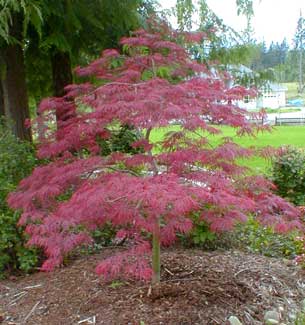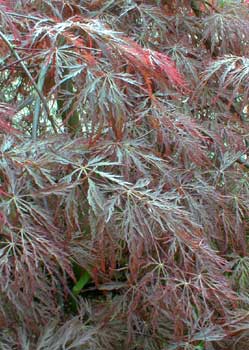
'Tamukeyama'
Purple Laceleaf Japanese Maple
"I do not compose prayers on bright silk
To present at your shrine,
But have only these maple leaves
From Mount Tamuke."
-Sugawara no Michizane
(845-903)
(845-903)
For Acer palmatum variant dissectum forma atropurpureum 'Tamukeyama,' the variant dissectum means it is a Laceleaf, Threadleaf, Split-leaf, or Cutleaf Japanese Maple. The form atropurpureum indicates purple-leaf. And its cultivar name is 'Tamukeyama.'
 Tamukeyama is named for Mount Tamukeya in Kyushu, also known as Mushashi's Mountain because it is the site of a shrine to the famous warrior Musashi Miyamoto (1584-1645), whose self-portrait is reproduced at the right.
Tamukeyama is named for Mount Tamukeya in Kyushu, also known as Mushashi's Mountain because it is the site of a shrine to the famous warrior Musashi Miyamoto (1584-1645), whose self-portrait is reproduced at the right.The meaning of the name Tamukeyama is literally "Hands folded in prayer (upon the) mountain" or "Mountain of Prayerful Offering." Tamuke can be anything spiritual, or any offering to the spirit world of divinities or of departed loved ones, but is in particular a traditional song originating among Zen monks, typically played upon the mournful shakuhachi (flute) for the souls of the remembered dead.
Especially in autumn, when bright red maple leaves arrive as prelude to deathly winter, maple-viewing inspires the same range of emotion as a beautifully played song for the dead. To sit beneath autumn maples meditating, flute-playing, or praying is the height of aesthetic angst in this world of beauty & sorrows.
 On a property I've helped landscape, this purple lace-leaf Japanese maple grows near a western cedar which gives it a small amount of shade part of the day. 'Tamukeyama' is one of the best of the upright, spreading, & semi-weeping to cascading red laceleaf maples. Its ten year height is eight feet; its width is ten feet.
On a property I've helped landscape, this purple lace-leaf Japanese maple grows near a western cedar which gives it a small amount of shade part of the day. 'Tamukeyama' is one of the best of the upright, spreading, & semi-weeping to cascading red laceleaf maples. Its ten year height is eight feet; its width is ten feet.Very old specimens can reach twenty or twenty-five feet, & will be wider than tall unless trained otherwise. The foliage emerges purple in April, ages to burgundy or maroon for summer, & turns bright red for autumn. It's a little more heat-hardy than most Japanese maples & much more sun-hardy than the typical cutleaf form, so it will hold its color even through droughty summers or in full sun, though its ideal is bright or dappled shade, especially while young. It'll also do well in Zone 9, though most varieties would be heat-exhausted above Zone 8.
An heirloom variety, 'Tamukeyama' has been known by this name in Japan since 1710. Because it is color-fast even in hot summers, it has never been displaced by newer cultivars. Many laceleaf varieties are very easily scortched in summer, but 'Tamukeyama' is uncommonly scorch resistant for a laceleaf.
Its tiny flowers are reddish maroon, appearing before leafbuds are fully opened. These turn into maroon winged samaras that last from spring to autumn before they are ripened. Young limbs & twigs tend to be deep burgundy, as can be seen in the leaf portrait from April. The bark on older specimens frequently aquires a frosty white surface.
'Tamukeyama' exists in high-graft & low graft forms. For the last decade or so, high graft forms have been most common here in the Northwest, but in some regions it seems that low-graft & mounded weepers are more abundant than the high-graft .
The low-graft more resemble the typical mounding & weeping 'Crimson Queen' but without 'Crimson Queen's' tendency to turn green in summer. The high-graft forms tend to be only semi-weepers, having upright trunks & a winding mix of horizontal & pendulous branches, typically trained airily so that the trunk & limb structure is visible, though it can also be permitted to become so densely limbed & leafed that its structure is only visible in winter.